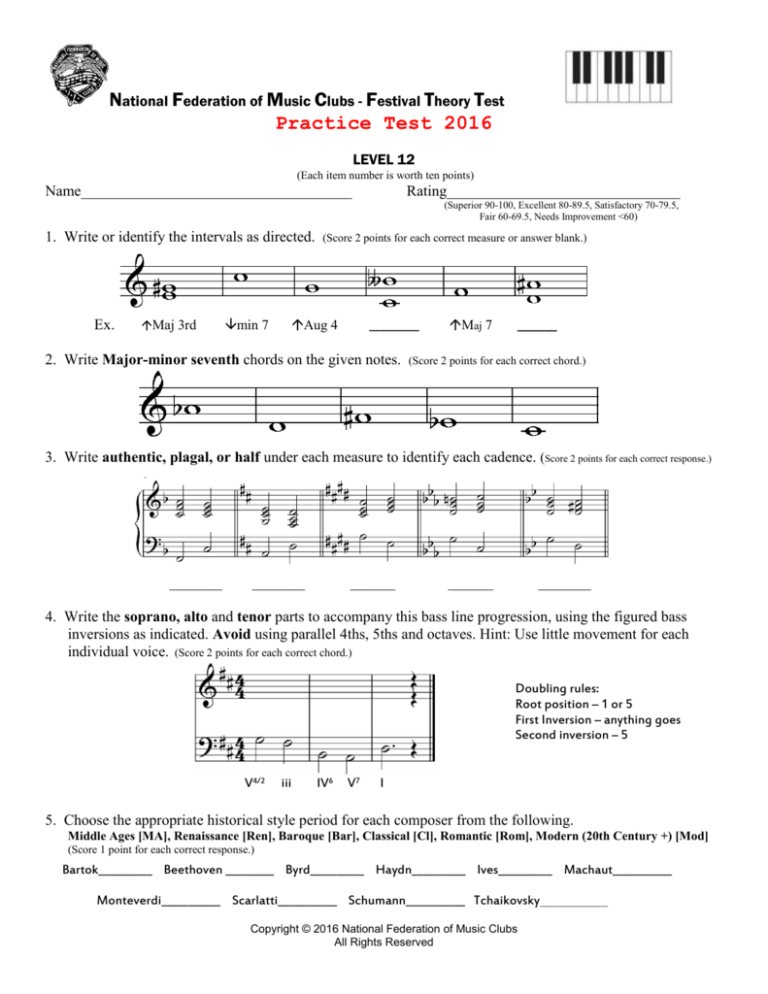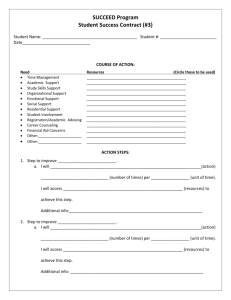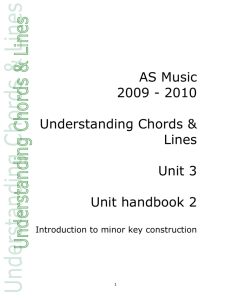
National Federation of Music Clubs - Festival Theory Test
Practice Test 2016
LEVEL 12
(Each item number is worth ten points)
Name____________________________________
Rating_______________________________
(Superior 90-100, Excellent 80-89.5, Satisfactory 70-79.5,
Fair 60-69.5, Needs Improvement <60)
1. Write or identify the intervals as directed.
Ex.
Maj 3rd
min 7
(Score 2 points for each correct measure or answer blank.)
Aug 4
_______
2. Write Major-minor seventh chords on the given notes.
_____
Maj 7
(Score 2 points for each correct chord.)
3. Write authentic, plagal, or half under each measure to identify each cadence. (Score 2 points for each correct response.)
_______
_______
______
______
_______
4. Write the soprano, alto and tenor parts to accompany this bass line progression, using the figured bass
inversions as indicated. Avoid using parallel 4ths, 5ths and octaves. Hint: Use little movement for each
individual voice. (Score 2 points for each correct chord.)
Doubling rules:
Root position – 1 or 5
First Inversion – anything goes
Second inversion – 5
V4/2
iii
IV6
V7
I
5. Choose the appropriate historical style period for each composer from the following.
Middle Ages [MA], Renaissance [Ren], Baroque [Bar], Classical [Cl], Romantic [Rom], Modern (20th Century +) [Mod]
(Score 1 point for each correct response.)
Bartok__________ Beethoven _________ Byrd__________ Haydn__________ Ives__________ Machaut___________
Monteverdi___________ Scarlatti___________ Schumann___________ Tchaikovsky____________
Copyright © 2016 National Federation of Music Clubs
All Rights Reserved
6. Transpose the following music to the key of A Major. Include key signature and time signature.
(From a total of 10 points, subtract 1 point for incorrect key signature; subtract 1 point for incorrect time signature; 2 points for each
incorrect measure.)
Write transposition here:
7. A. Add a time signature in front of each staff. Add bar lines and double bar line to the staff
(From a total of 10 points in both A and B, subtract 2 points for each missing or incorrect time signature, 1/2 point for each bar line – double
bar line, and 1 point for each incorrect beam)
_____
_____
B. Rewrite the notes, grouping them according to the time signature by using beams.
8. A. Match the definition with the correct term from the box. Not all terms will be used.
(Score 1 point for each correct response.)
___ composition for several a cappella voices set to a secular poem
___ secular vocal solo composition popular in the Middle Ages
___ melody with chordal accompaniment
___ polyphonic choral composition set to Latin sacred text
___ two or more melodic lines of equal importance sounding simultaneously
___ choral composition set to 5 standard Latin sacred texts used in Catholic Church service
___ medieval polyphony made up of Gregorian chant and one or more added melodic lines
1 chanson
2 Gregorian chant
3 homophonic
4 madrigal
5 mass
6 monophonic
7 motet
8 organum
9 polyphonic
10 sacred
11 secular
12 troubadour
___ melody only, no harmony
B. The dates for the Renaissance period of music history are ______ to ________.
The Middle Ages music historical period extended from _____ to ______.
(Score 2 points for all 4 dates, subtract .5 for each incorrect date.)
9. For each group of instruments, assign a chamber ensemble label (for example, “brass quartet”).
(Score 2 points for each correct response.)
a.
b.
c.
d.
e.
Two violins, viola, cello
Two trumpets, French horn, trombone, bass trombone
Violin, viola, cello
Flute, oboe, clarinet, bassoon, French horn
Piano, violin, cello
___________________________
___________________________
___________________________
___________________________
___________________________
10. Write an ascending and descending melodic minor scale on F#. Include a clef and key signature.
Score 2 points for correct key signature, 8 points for correct ascending and descending scale. Subtract 1 point if clef is missing; subtract 1 point
for any incorrect ascending or descending pitch, but no more than 10 total.)
NFMC Festival Theory Test Level 12 p. 2






